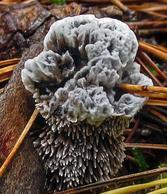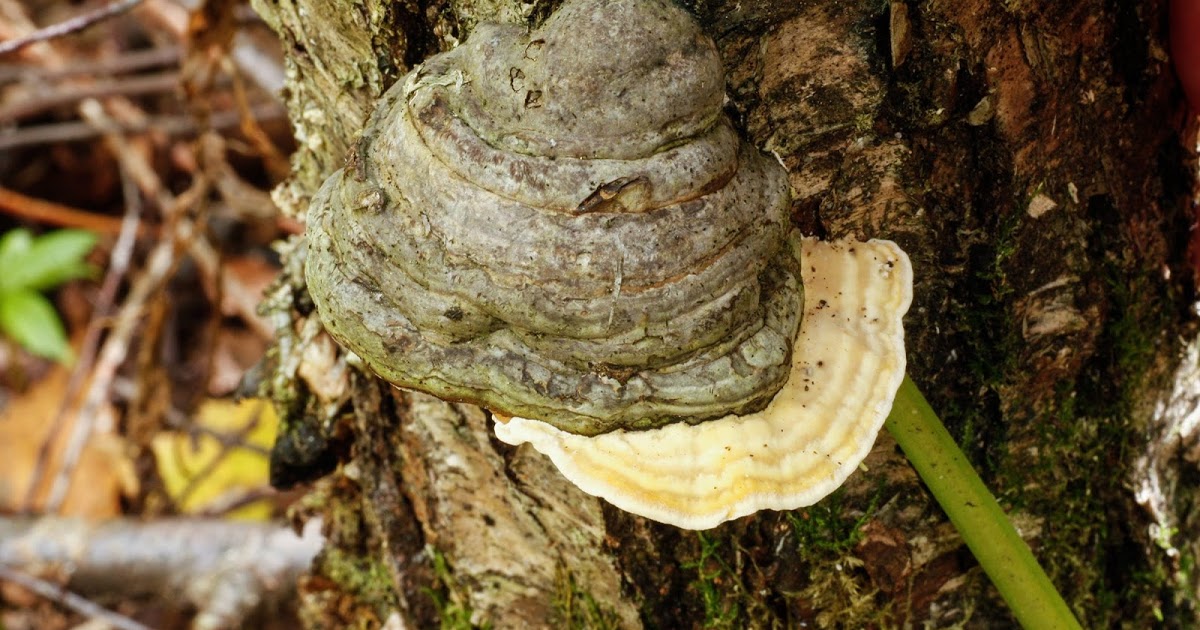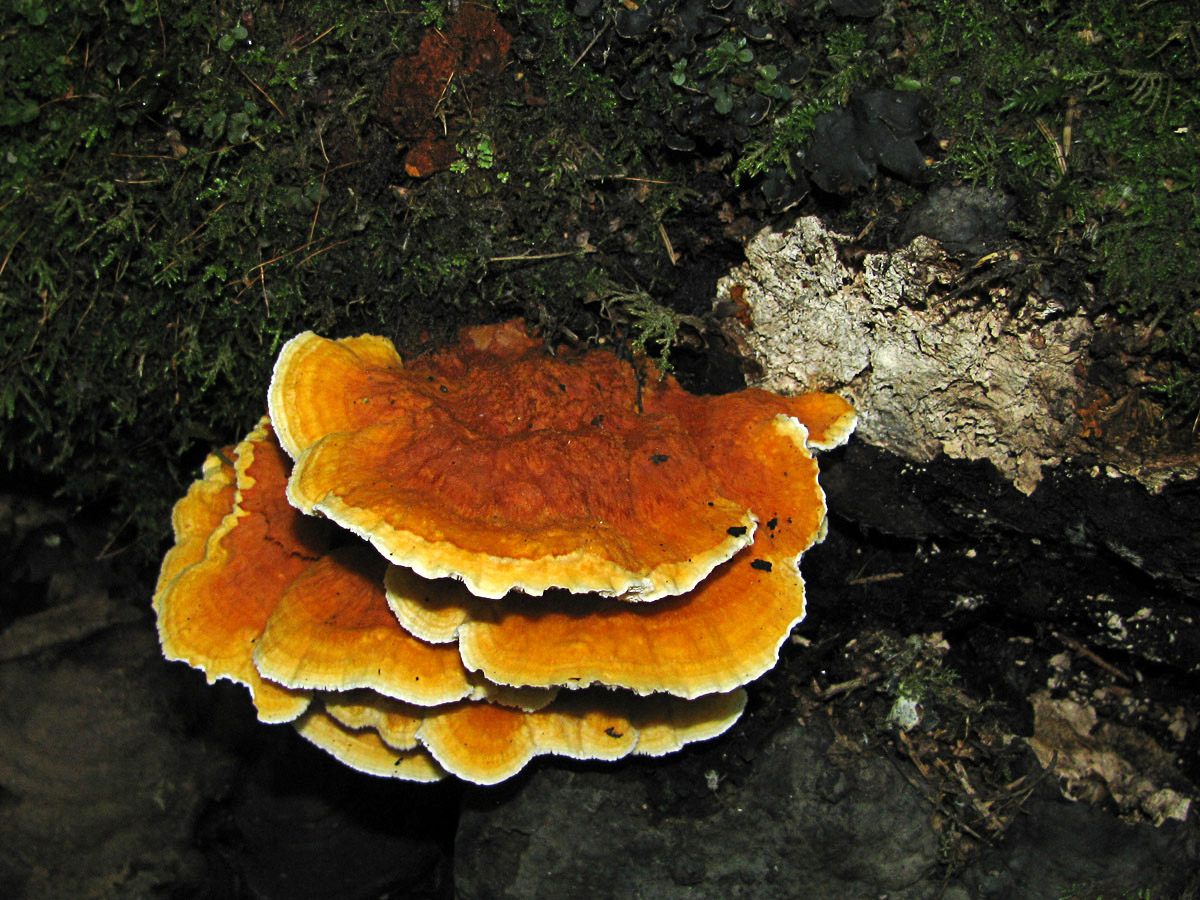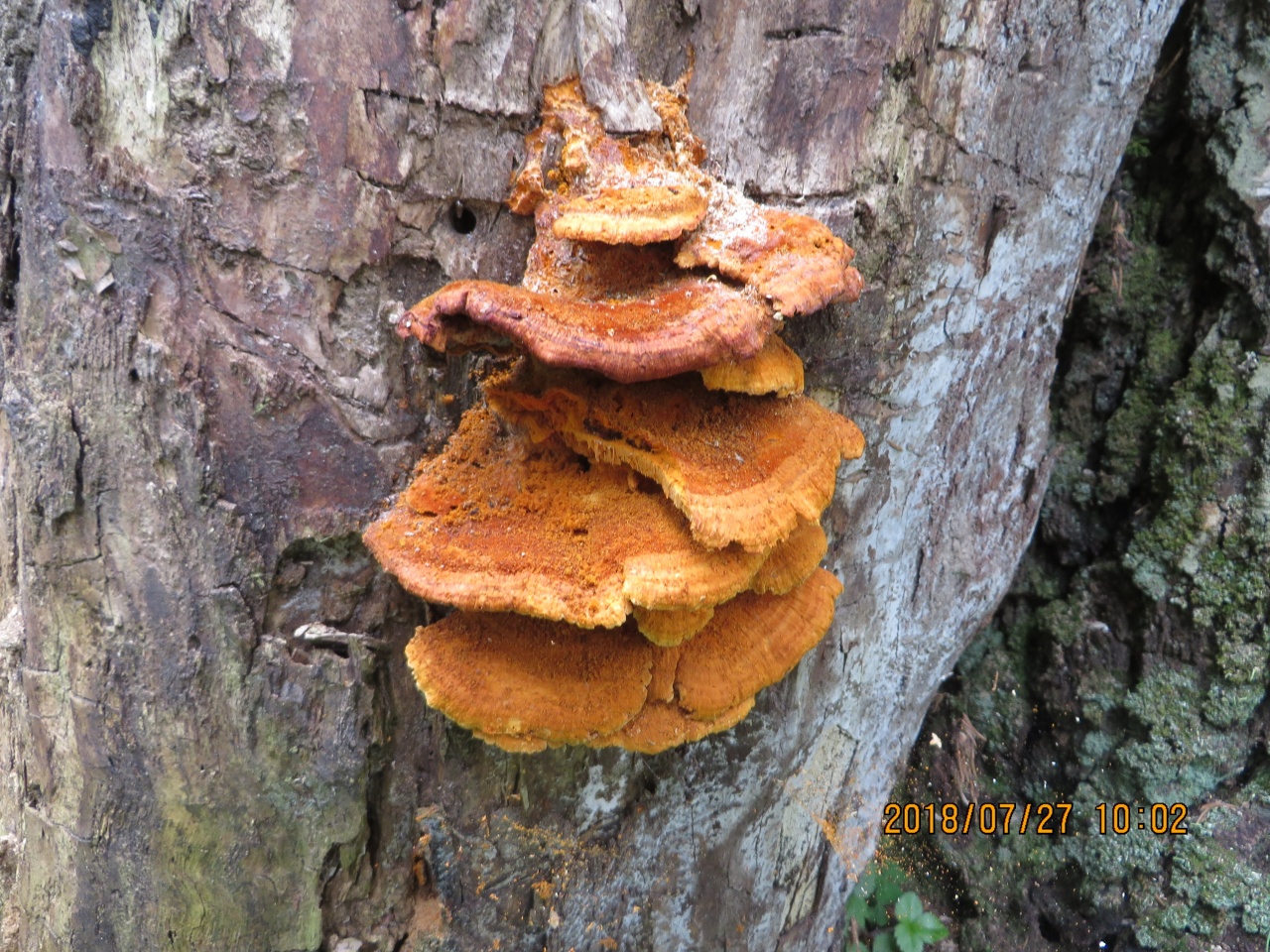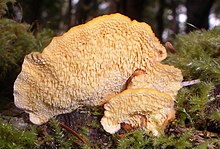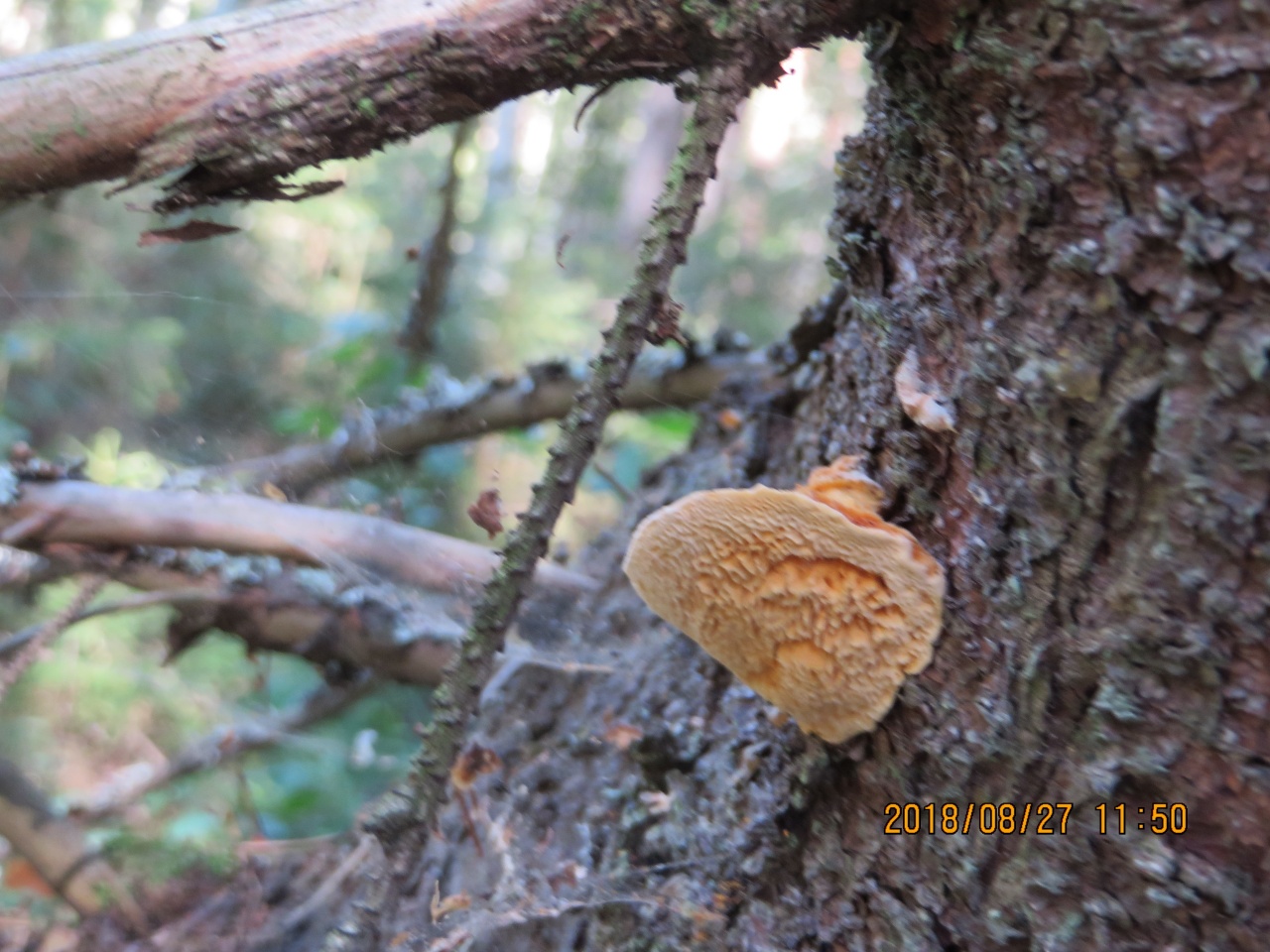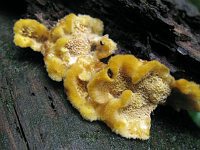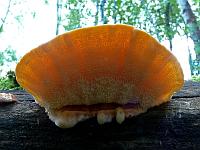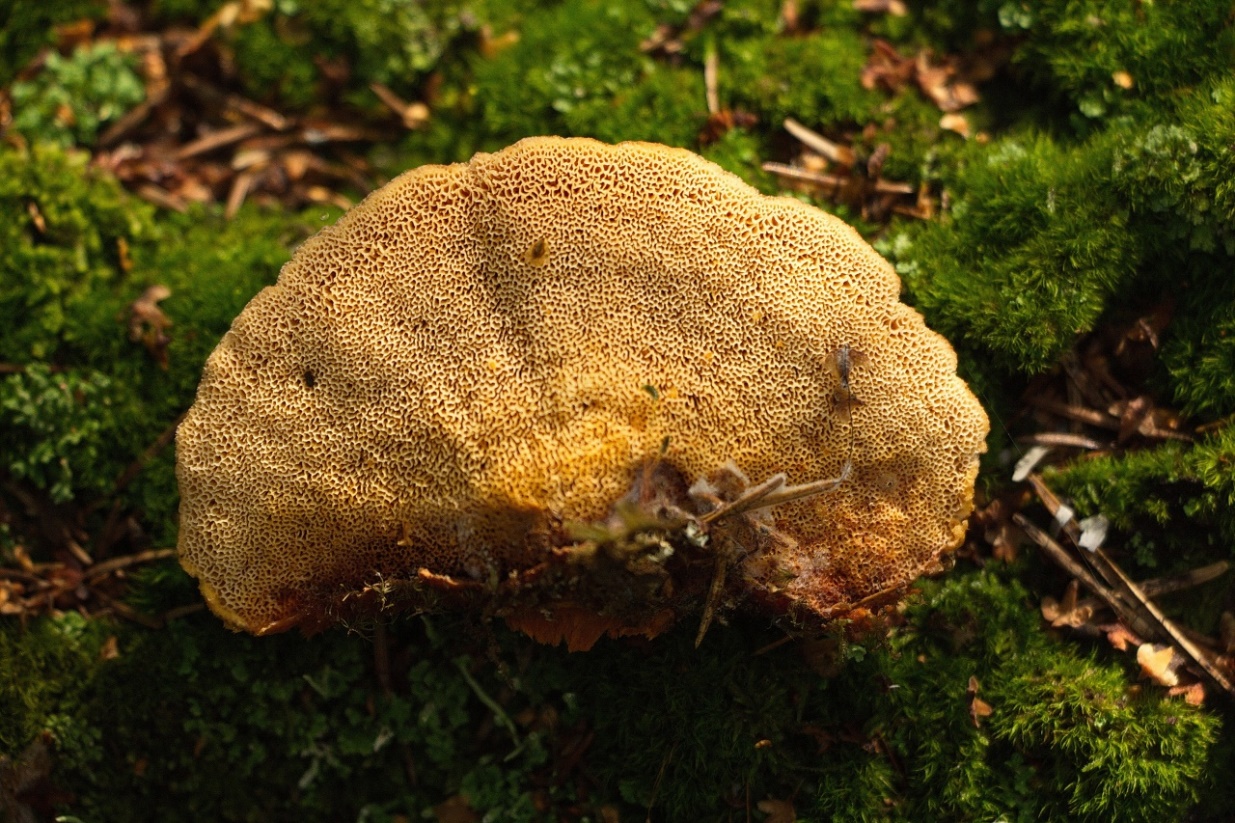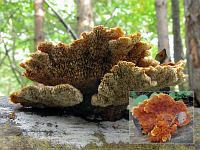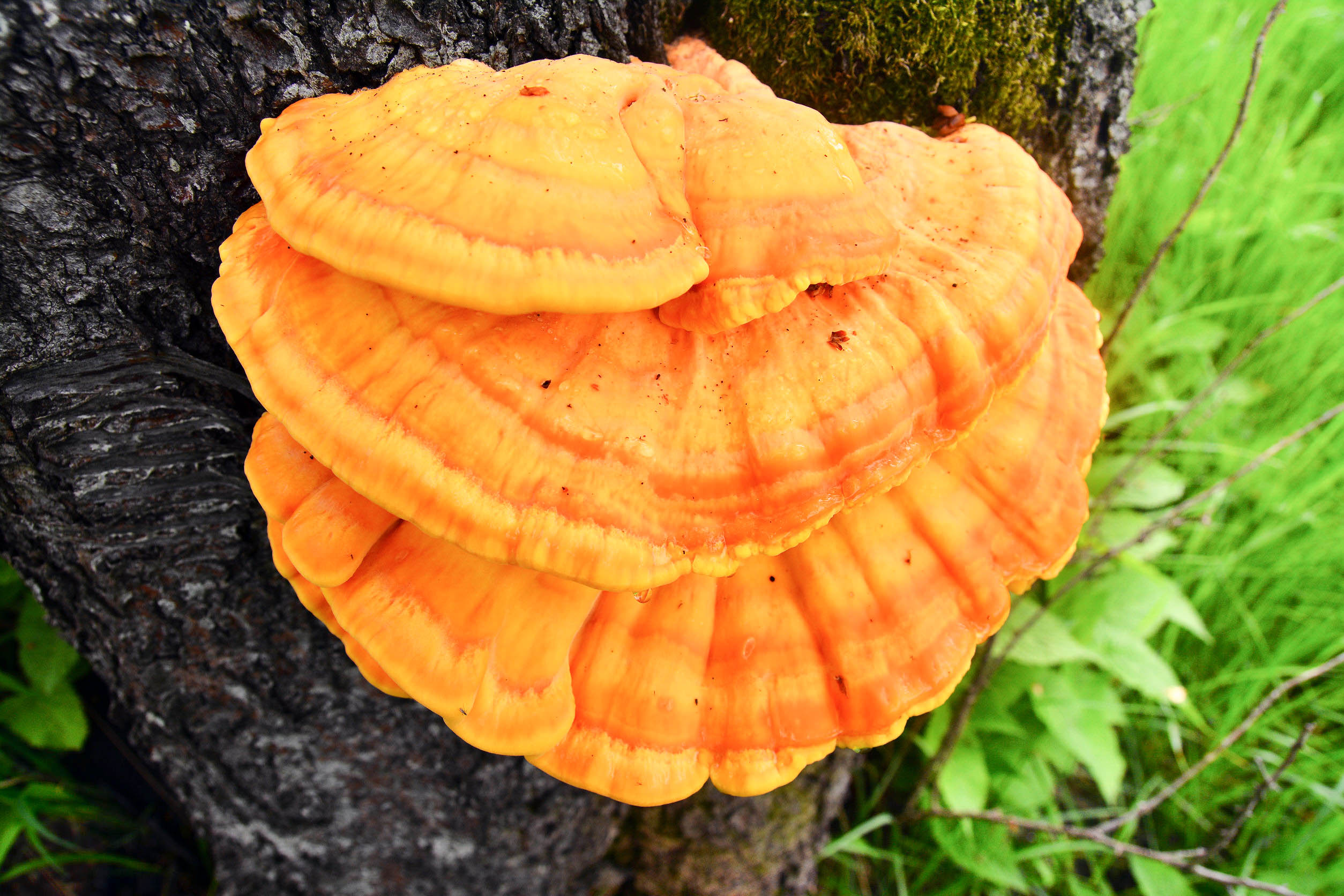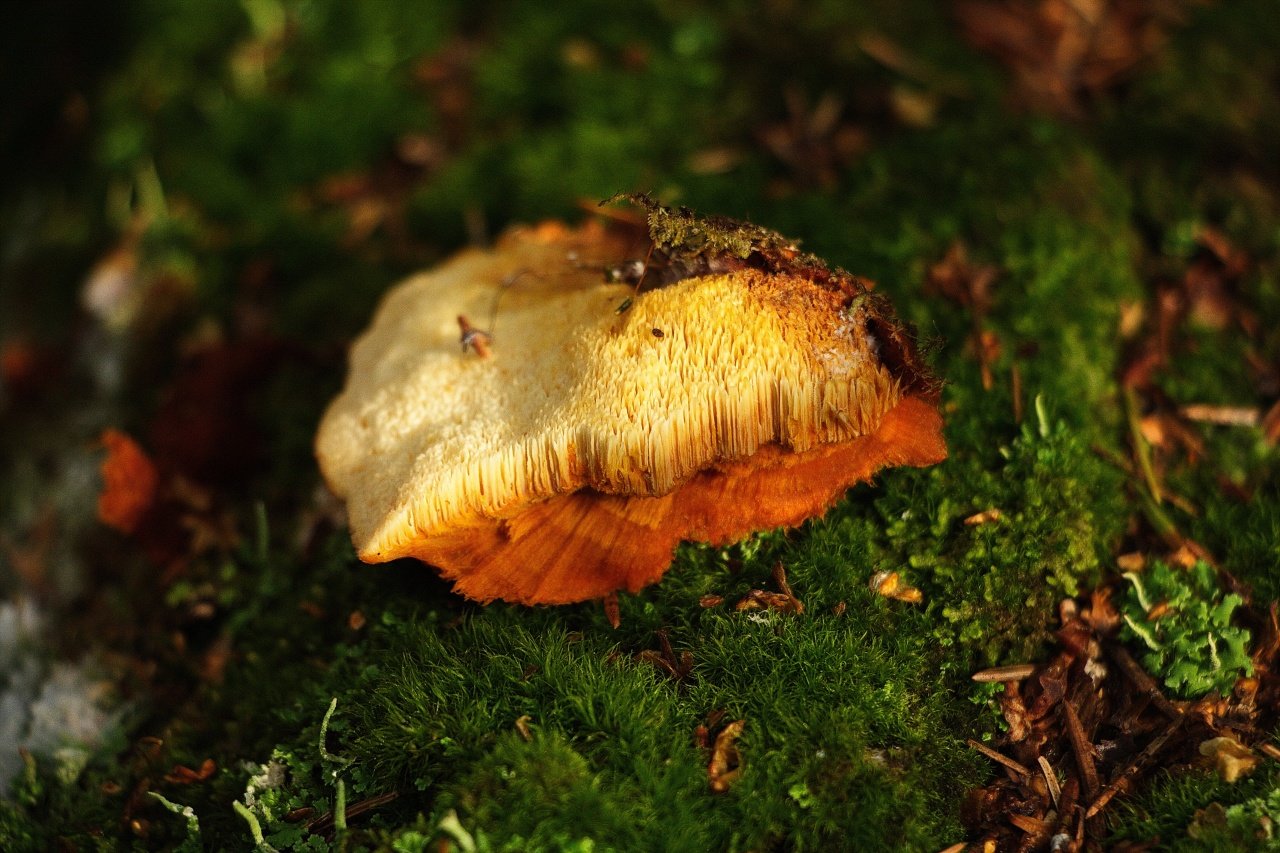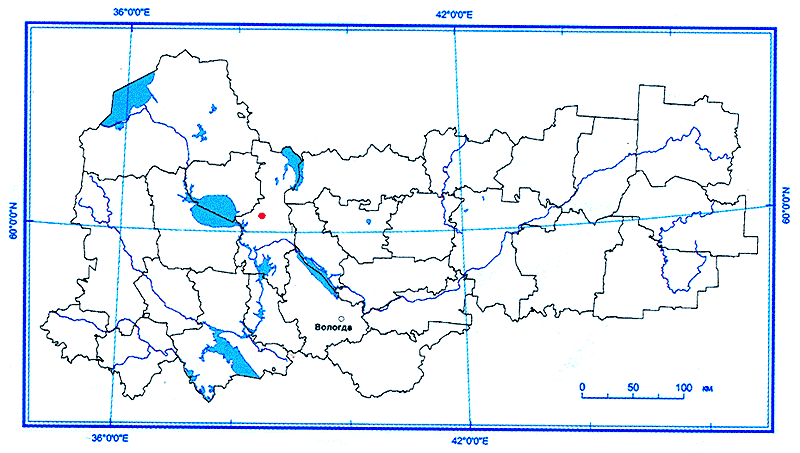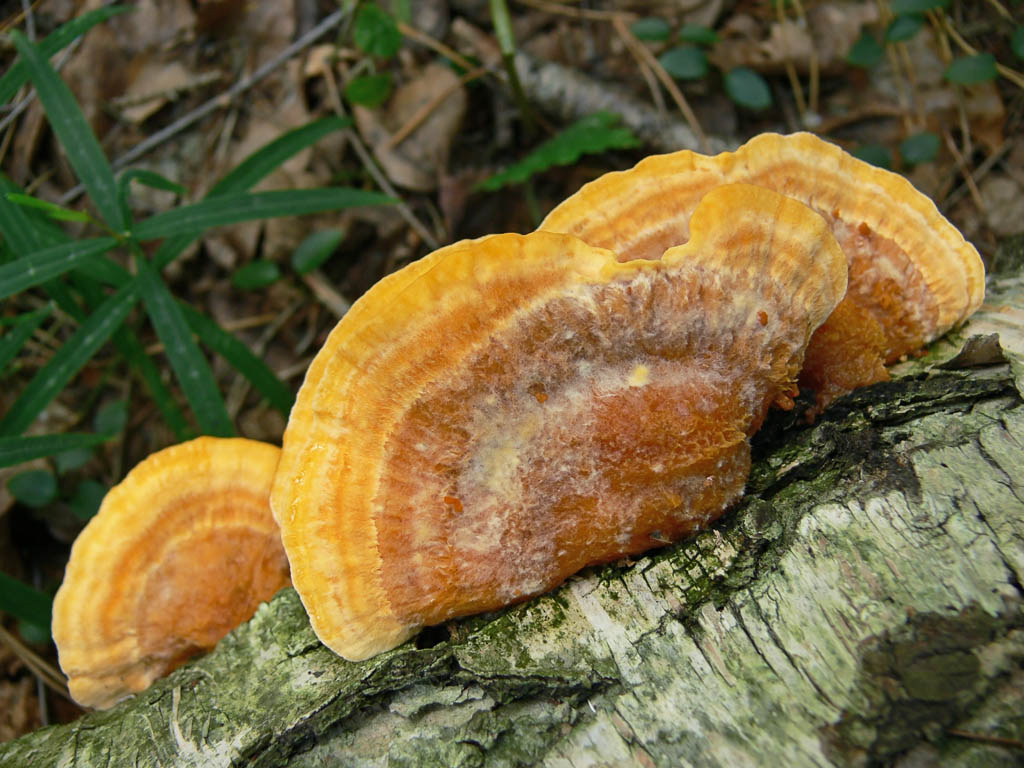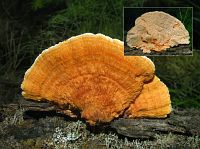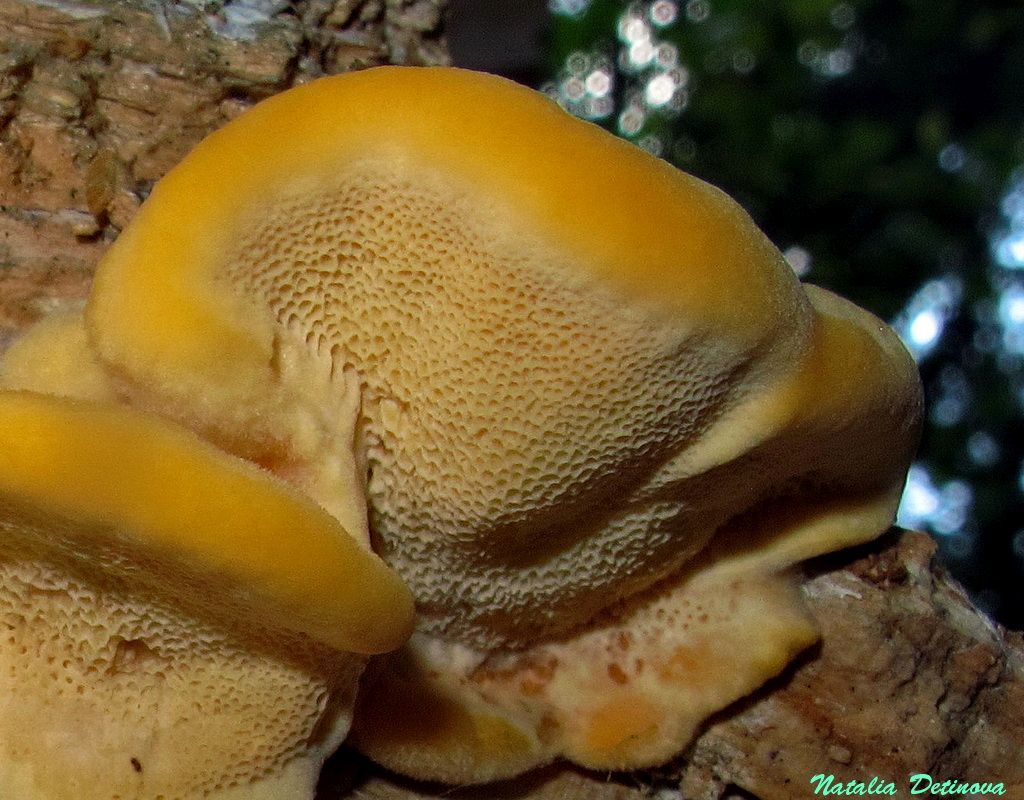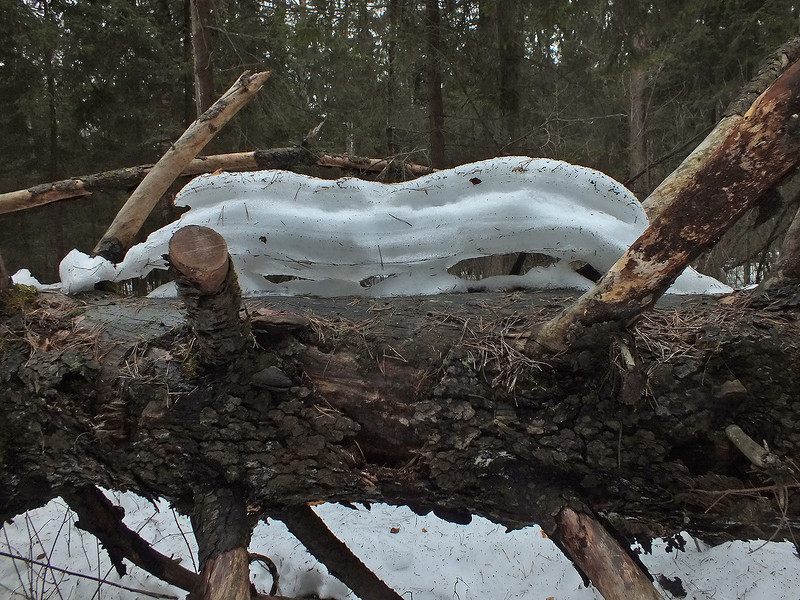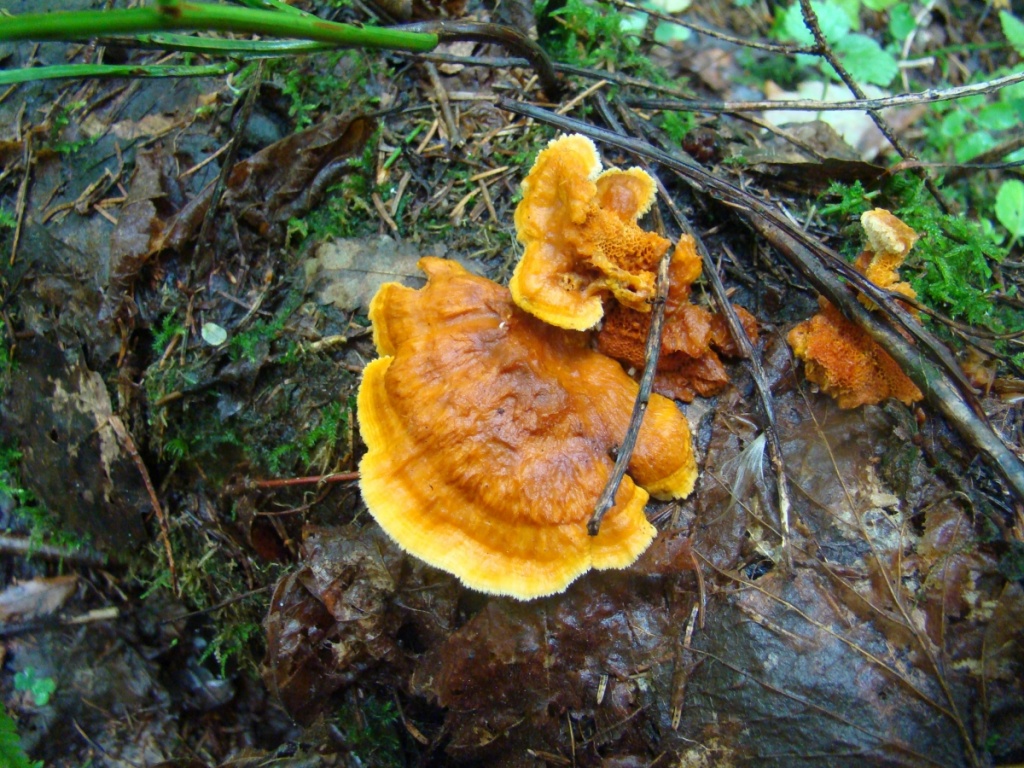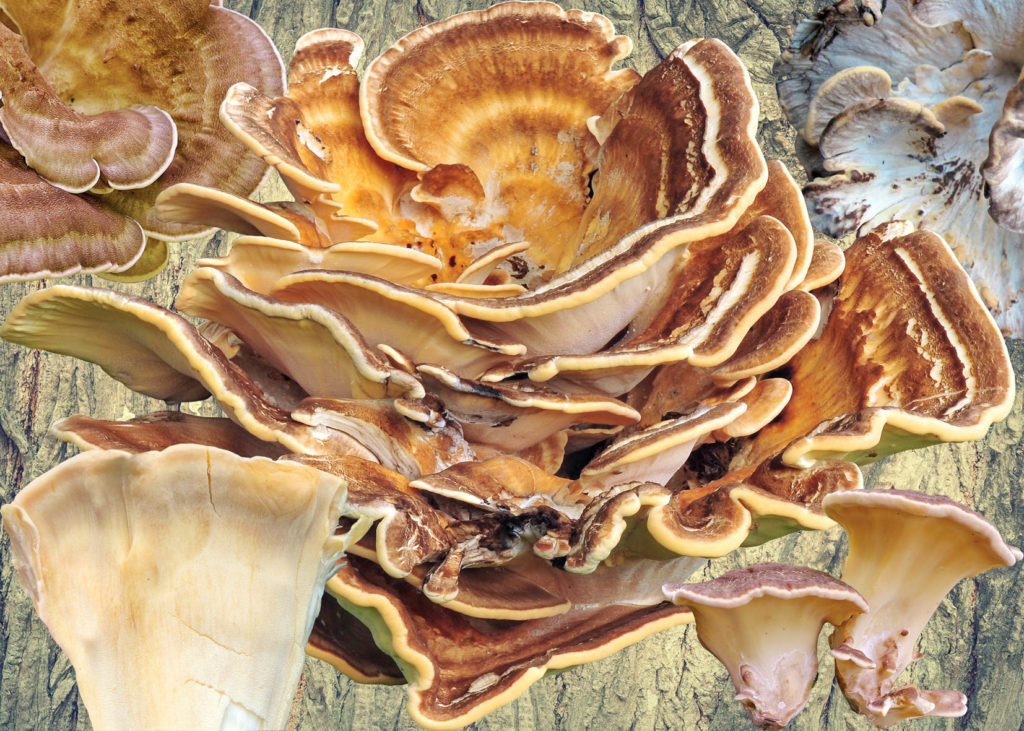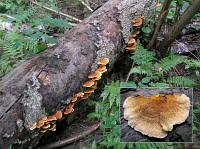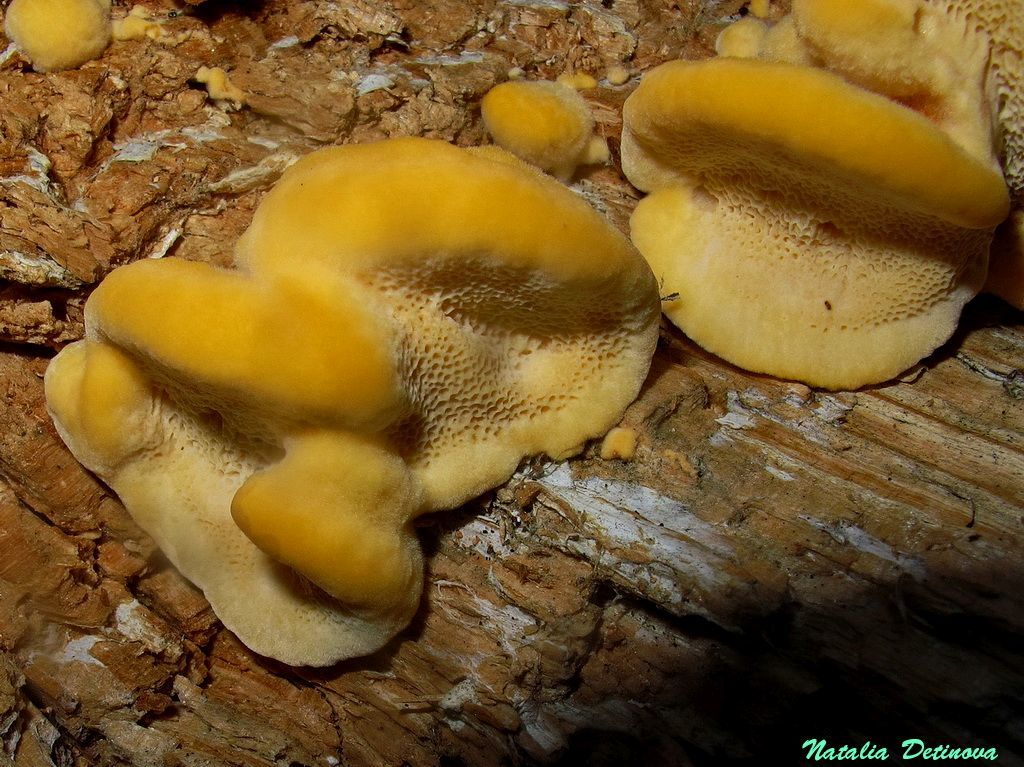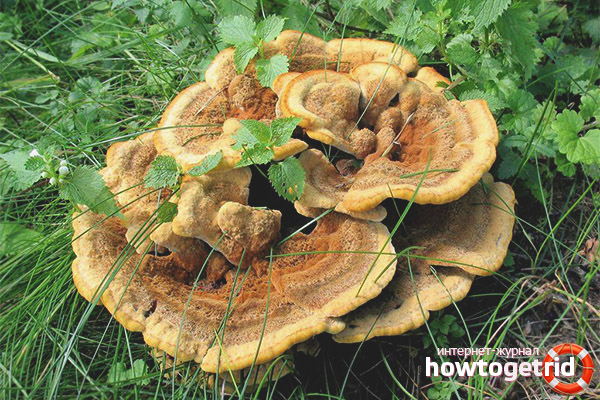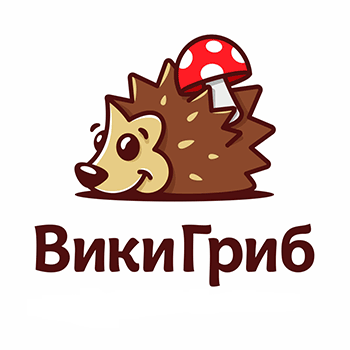Cinnabar red polypore (Pycnoporus cinnabarinus) how it looks, where and how it grows, edible or
Polypore cinnabar red: photo and description
The cinnabar red polypore is attributed by scientists to the Polyporovye family. The second name of the mushroom is cinnabar-red pycnoporus. In Latin, the fruiting bodies are called Pycnoporus cinnabarinus.
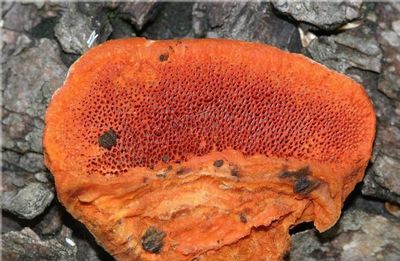
The view has a very catchy color
Tinder fungi include types of fungi that develop on a tree. It is not often possible to meet it on the ground.
Description of cinnabar tinder fungus
The fungus has a sessile hoof-shaped fruiting body. Sometimes it is round. The diameter of the fungus is 6-12 cm, the thickness is about 2 cm. The color of the tinder fungus changes during its growth. Young specimens are colored in a cinnabar-red hue, after which they fade and acquire an ocher or light carrot tone. The pores are regularly cinnabar red. The fruit is adherent, the flesh is red, with a cork structure. The upper surface of the mushroom is velvety. Cinnabar-red pycnoporus belongs to annual mushrooms, but can persist for a long time on the tree. The mushroom owes its own color to the cinnabarin dye of a similar shade, which, according to scientists, has antiviral and antimicrobial effects.
Disputes in the species are tubular, average size, white powder.
Inhabits weakened or dead trees
Where and how it grows
Red polypore is considered a cosmopolitan. It has a wide growing region. In our country, it is found in absolutely any region. Only the tropical climate will not suit the mushroom, there are no similar regions in the Russian Federation. Therefore, the tinder fungus is found throughout the territory from the European part of the country to the regions of the Far East.
Mushrooms grow in groups in random order
Pycnoporus grows on dead or weakened trees. It can be found on twigs, trunks, stumps. Prefers deciduous trees - birch, mountain ash, aspen, cherry, poplar. As a rare exception, red tinder fungus can settle on needles. Fungi cause the development of white rot, but it does not penetrate deep into the wood.
Fruiting from late May to November. The fruit bodies on the trees will be preserved during the winter.
Fruit bodies look like a bright spot among white snow
How fruiting bodies grow is shown in the video:
Eat a mushroom or not
Belongs to the inedible group, the species is not eaten. No toxic substances were found in its composition, but the rigidity of the fruit bodies does not make it possible to prepare any edible dish from them.
Doubles and their differences
The coloring of the fruit body is so unique that it is almost impossible to confuse it with any other species. But still, there are slightly the same instances. In the Far East, there is a similar pycnoporus - blood-red (Pycnoporus sanguineus). His fruiting bodies are much smaller and more intensely colored. Therefore, mushroom pickers, due to inexperience, can confuse the species.
The small size of the fruiting body clearly distinguishes the blood-red tinder fungus from the cinnabar red
Another species that has an outward resemblance to cinnabar red is the brilliant Pycnoporellus (Pycnoporellus fulgens). Its cap is distinguished by its orange color, and there is a view on the spruce tree. Such characteristics make it possible not to confuse the species.
The species grows on spruce wood, in contrast to the cinnabar-red tinder fungus
The common liverwort (Fistulina hepatica) has a slight resemblance in appearance. It is an edible pycnoporus from the Fistulin family. This mushroom has a smooth, shiny cap surface. The pulp is thick and fleshy. It prefers to settle on oak or chestnut trunks, the fruiting season is the end of summer.
Many people gladly include the liverwort in their own diet.
The use of cinnabar red tinder fungus in industry
While developing, the fungus destroys the lignin contained in the tree.This process is carried out using enzymes that are used in the paper industry - laccase. Therefore, the type is called technical and is used during the production of cellulose from industrial waste. Laccase makes plant cells woody.
Conclusion
Cinnabar red tinder is not very common. Examining the external description will help you not to confuse the mushroom with the edible species of the family.
Pluggable locator:
 Close up Chanterelle fffi
Close up Chanterelle fffi
 Bump, bump
Bump, bump
 Heart and soul. Soothing and soaring Burgundy flare
Heart and soul. Soothing and soaring Burgundy flare
.
 Contact
Contact
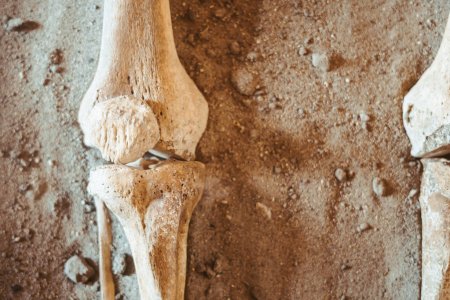 Power supply
Power supply
 Burgundy, birch bark, bark, bark Likewise, lolly, lolly, lolly. Open contact. Point, point, point, point. L l l l l l l l l l l l l l l l l l. Bunker
Burgundy, birch bark, bark, bark Likewise, lolly, lolly, lolly. Open contact. Point, point, point, point. L l l l l l l l l l l l l l l l l l. Bunker
.
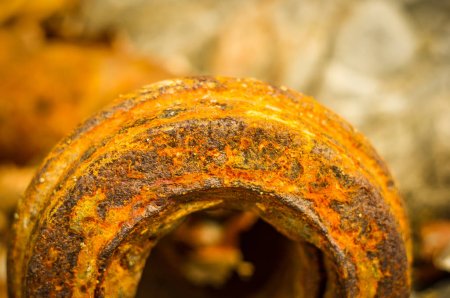 Burgundy, baptism, bark
Burgundy, baptism, bark
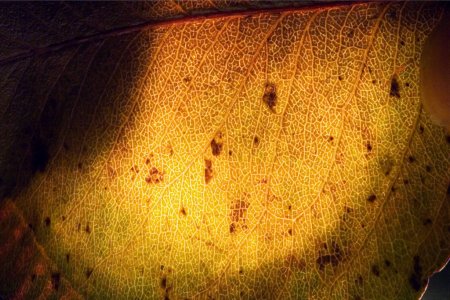 Burgundy
Burgundy
Sub-cherry (Clitopilus prunulus)
Synonyms:
- Ivishen
- Cherry
- Common clitopilus
Hanging hat:
4-10 cm in diameter, convex in youth, opens to funnel-shaped with age, although not always. The color is quite changeable, from white to yellowish-gray, can vary significantly depending on the growing conditions and the specific "strain". The surface is smooth, dry or slightly damp, shiny (the latter variety is sometimes called Clitopilius prunulus var. Orcellus), not hygrophilous and not zoned. The flesh of the cap is white, thick, firm, with a strong mealy (or maybe cucumber) odor.
Plates:
Private, descending along the leg, the color of the cap; with age, as the spores mature, they turn slightly pink (judging by the suffering with the definition of the fungus, it is not always noticeable).
Spore powder:
Pink.
Leg:
Height 3-6 cm, thickness about 1 cm (in rare cases up to 1.5 cm), uneven, often curved, solid. Color - like a cap or slightly lighter, the flesh of the leg is white, fibrous.
Spreading:
Various varieties of the Bearberry are found from July to the end of September everywhere in forests of various types, in woodlands, among grasses, invariably preferring acidic soils. The fungus forms mycorrhiza, as a rule, with pink flowers, but it is also found in spruce forests without the slightest traces of apple and cherry trees.
Similar species:
The genus Clitopilius contains a huge number of species, a significant part of which is extremely similar to Clitopilius prunulus and differs only in microscopic features. Another thing is that many white talkers can look like a wonderful mushroom. Pinking plates (alas, not always and not strongly), a non-hygrophane cap without concentric circles (excellent protection against poisonous waxy talker (Clitocybe cerussata) / leaf-loving (Clitocybe phyllophila))
In general, it is important to understand that a sub-cherry is a mushroom, very similar to a large white chanterelle, but smelling of flour or cucumbers.
Edible: The mushroom is edible and, according to some sources, is considered highly valuable, however, the strong flour smell is not to everyone's taste, and the resemblance to poisonous talkers and entolomes unknown in the nutritional sense makes gastronomic ambitions moderate.
Remarks Now it's easy to say, but that's how we, to put it bluntly, are pretty much worn out with this. A mushroom similar to a large white fox came across to me often and regularly, every time annoying and baffling.More for the sake of order than for common sense, I considered him a waxy talker, but you can't deceive yourself endlessly. The main problem was that the appearance of the familiar mushroom was so "talkative" that it never occurred to me to conscientiously pluck an adult specimen and sow spores to see their color. As soon as this was done, there was a long-awaited clarification; Yes, we have before us a simple willow, Clitopilius prunulus, or rather, one of the countless subspecies of this extremely fickle species of mushrooms.
Pycnoporellus brilliant (Pycnoporellus fulgens)
Synonyms:
- Creolophus fulgens
- Dryodon fulgens
- Polyporus fibrillosus
- Polyporus aurantiacus
- Ochroporus lithuanicus
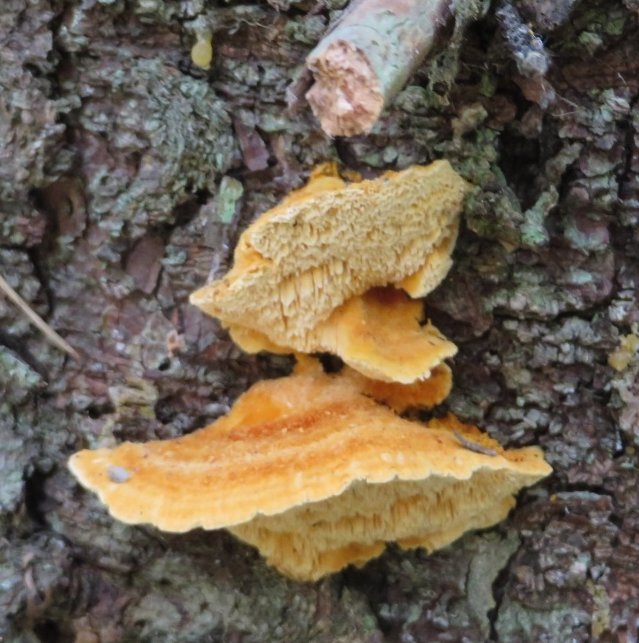
Ecology and distribution
Pycnoporellus lustrous lives on dead wood, causing brown rot. Most often it can be seen on a spruce tree, on which the bark is partially preserved. It is rarely found on pine, as well as on alder, birch, beech, linden and aspen. At the same time, he almost always settles on a valezh, on which the bordered tinder fungus has already "worked".
This species is confined to old forests (at least to those in which sanitary felling is rarely carried out, and there is a suitable quality deadwood). In principle, it can be found in the city park (again, there would be a suitable deadwood). The species is common in the northern temperate zone, but is rare. The period of active growth is from spring to autumn.
Description
Fruiting bodies are annual, more often they look like tiled sedentary semicircular or fan-shaped caps, less often prostrate-bent forms are found. The upper surface is painted in more or less bright orange or orange-brown shades, naked, velvety or slightly pubescent (bristly in old fruiting bodies), often with pronounced concentric zones.

The hymenophore in young fruiting bodies is creamy.
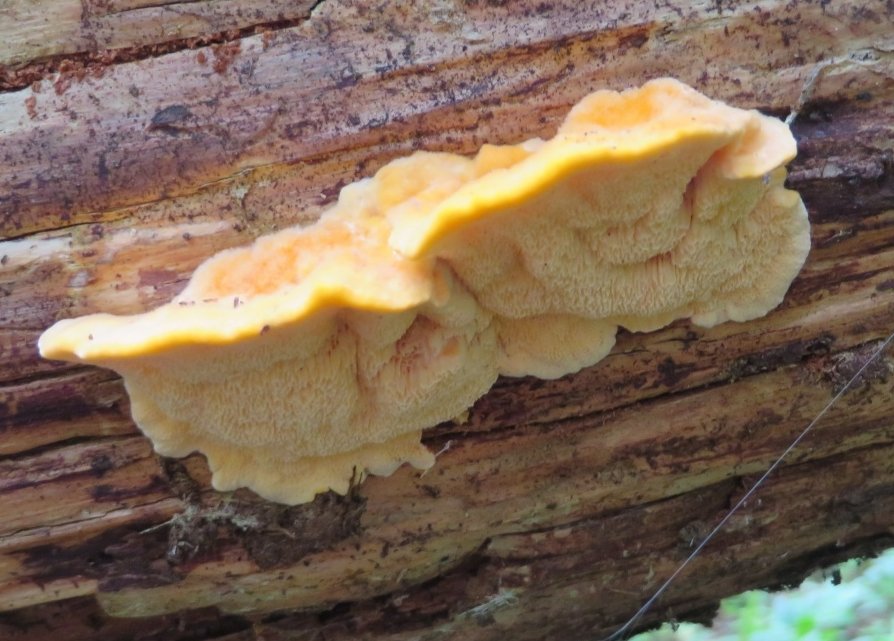
Older ones have pale orange, with angular thin-walled pores, 1-3 pores per mm, tubule length up to 6 mm. With age, the walls of the tubules break, and the hymenophore turns into an irpexoid, consisting of flat teeth protruding from under the edge of the cap.

The pulp is up to 5 mm thick, light orange, fresh with the consistency of a soft cork, sometimes two-layer (then the lower layer is dense, and the upper fibrous), when dry it becomes light and brittle, when in contact with KOH, it first turns red, then turns black. Smell and taste are not pronounced.
Spore powder is white. Spores are smooth, from cylindrical to ellipsoidal, non-amyloid, do not redden in KOH, 6-9 x 2.5-4 microns. Cystyds are irregularly cylindrical, do not turn red in KOH, 45-60 x 4-6 microns. The hyphae are mostly thick-walled, weakly branching, 2-9 µm thick, in KOH they remain colorless or are painted in reddish or yellowish shades.
Similar species
It differs from Pycnoporellus alboluteus in that it forms well-shaped caps, has a denser consistency, when in contact with KOH, it first turns red and then blackens (but does not become cherry). At the microscopic level, there are also differences: spores and cystids are smaller in it, and hyphae are not stained with KOH in a bright red color.
Photo: Marina.
Pycnoporellus brilliant: photo and description
| Name: | Pycnoporellus brilliant |
| Latin name: | Pycnoporellus fulgens |
| Type of: | Inedible |
| Systematics: |
|
Pycnoporellus brilliant (Pycnoporellus fulgens) is a bright representative of the mushroom world. In order not to confuse it with other species, you need to know how it looks, where it grows and how it differs.
Description of pycnoporellus brilliant
Shiny pycnoporellus is also known under a different name - shining tinder fungus. This is a species belonging to the basiomycetes from the Fomitopsis family.
The body of the fungus is a sessile or half-fan-shaped cap, which rarely grows strongly. Its dimensions range from 8 cm in length to 5 cm in width.The leg is pronounced (if any). The edges are drooping, uneven, sometimes torn. The color is dull, yellowish-white, later turning into orange and crimson. The surface is smooth and shiny, sometimes with a velvety bloom, closer to the base, bumpy and rough, with light or almost white borders of the cap.
The inner layer is fleshy, large-pored, sometimes dissected in old specimens. Over time, it is subject to destruction, decay and insect attack. The pores are filled with a pale gray powder, long, irregular in shape, often with split or ragged edges. Color from beige to pale orange, lightening towards the edges.
Fresh mushroom, when broken, exudes a pungent rare odor. The center is dense, fibrous, yellowish or creamy. When dry, the pulp becomes brittle and brittle.
Colonies of pycnoporellus lustrous often infect wood, which is already parasitized by other species of organisms.
Vibrant coloration makes the brilliant pycnoporellus stand out from the forest greenery
Where and how it grows
Shiny pycnoporellus grows mainly in spruce forests, mixed forests, on deadwood (pine, spruce, fir), less often on the trunks of dead deciduous trees (aspen, birch, oak). Loves high humidity, shade, parasitizes on dead colonies of other fungi.
In Russia, pycnoporellus brilliant is widespread in the Nizhny Novgorod region, appears from the beginning of summer, grows until late autumn. It is also found in the Leningrad region - to the north-west of St. Petersburg, but not very often.
Is the mushroom edible or not
Pycnoporellus brilliant has a mild taste. No food intake data documented. In medicine, an extract from the body of brilliant pycnoporellus is used to combat pathogenic bacteria of the genus Candida. There is unverified evidence that pycnoporellus brilliant, when consumed raw, has a weak inhibitory effect on the nervous system and causes hallucinations.
Doubles and their differences
It is easy to confuse pycnoporellus lustrous with similar types of mushrooms:
- Tinder cinnabar has similar external data: a sedentary rounded fruiting body up to 2 cm thick and up to 12 cm in diameter. Young specimens are painted in bright carrot, red, orange shades. As it grows and ages, the color changes to ocher or brownish-carrot color. Cork pulp, velvety surface on young mushrooms, rough on old ones. It is an annual representative of the mushroom kingdom, but spores can persist for a long time in the ground or wood. Not edible. It differs from brilliant pycnoporellus in a brighter color, pore size and branching of the edges.
The vermilion cinnabar is a food source for many forest insects.
Radiant inonotus grows freely on rotten or semi-dead trunks of alder, linden and even birch
Tyrometses kmeta resembles a slice of lemon or other citrus fruit, adherent to a tree
Conclusion
Pycnoporellus brilliant - an amazing representative of its family, but poorly studied and not suitable for human consumption. It has several twins, differing in the place of growth and in some external features.
L-L-L-L-L:
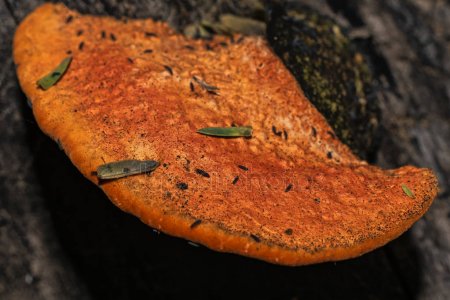 Pycnoporellus fulgens, lily, lily, lily, lily and lily. Pycnoporus cinnabarin
Pycnoporellus fulgens, lily, lily, lily, lily and lily. Pycnoporus cinnabarin
 Geoffroea decorticans
Geoffroea decorticans
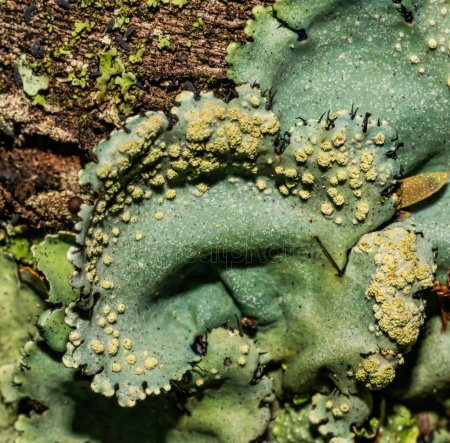 Bark and bark and bark. Flare-up and back-to-back Bustle
Bark and bark and bark. Flare-up and back-to-back Bustle
.
 Bark and bark and bark. Close up and down again Bustle
Bark and bark and bark. Close up and down again Bustle
.
 Geoffroea decorticans
Geoffroea decorticans
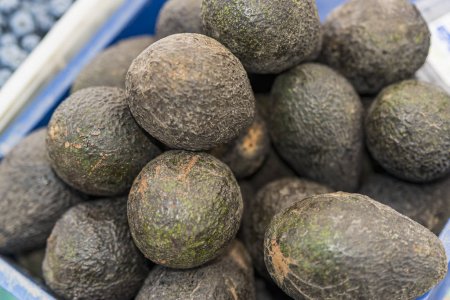 Burgundy, bark, bark, bark Rose, Rose, Rose, Rose, Rose, Rose, Rose, Rose
Burgundy, bark, bark, bark Rose, Rose, Rose, Rose, Rose, Rose, Rose, Rose
.
 Donkey, donut, donut, donut, donut.Bump, bump, bump, bump RESTAURANT
Donkey, donut, donut, donut, donut.Bump, bump, bump, bump RESTAURANT
.
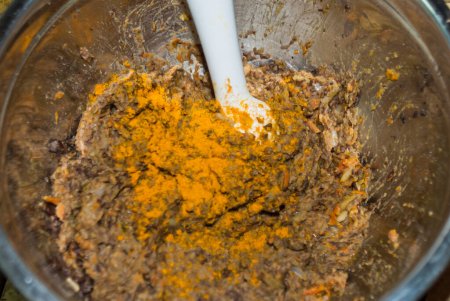 Donkey, donut, donut, donut, donut. Bump, bump, bump, bump RESTAURANT
Donkey, donut, donut, donut, donut. Bump, bump, bump, bump RESTAURANT
.
Brush telephon (Thelephora penicillata) what mushrooms look like, where and how they grow, are they edible or not
Brush telephon: photo and description
| Name: | Brush telephon |
| Latin name: | Thelephora penicillata |
| View: | Inedible |
| Synonyms: | Merisma penicillatum, Merisma cristatum var penicillatum, Merisma fimbriatum, Thelephora cladoniiformis, Thelephora cladoniaeformis, Thelephora mollissima, Thelephora spiculosa |
| Specifications: |
|
Brush telephon is a rather rare mushroom with a cap fruit body. Belongs to the class Agaricomycetes, the Telephora family, the Telephora genus. The name in Latin is Thelephora penicillata.
How does a brush phone look like?
Thelephora penicillata has a beautiful appearance. The fruiting body is a bunch of dark fluffy tassels, lighter at the tips. Rosettes growing on stumps look much more beautiful than those growing on the ground. The latter look crumpled and trampled, although no one touches them. The color of the rosettes is violet-brown, violet, reddish-brown at the very base; in the transition to the branched tips, it is brownish. The strongly branched ends of the rosettes end in sharp spines of a whitish, creamy or cream shade.
The size of the telephony rosettes can reach 4-15 cm in width, the length of the spikes is 2-7 cm.
The flesh of the mushroom is brown, fibrous and soft.
The spores are warty, elliptical in shape, ranging in size from 7-10 x 5-7 microns. The spore powder is purplish brown.
Eat a mushroom or not
The telephon is not edible. Its flesh is thin and tasteless, with the smell of dampness, earth and anchovy. Has no gastronomic interest. The toxicity has not been confirmed.
Where and how it grows
In our country, Telefora brush is found in the middle lane (in the Leningrad, Nizhny Novgorod regions). Popular on the European mainland, Ireland, England, and also in North America.
It grows on plant remains (fallen twigs, leaves, stumps), rotten trees, soil, forest floor. It settles in wet coniferous, mixed and deciduous forests next to alder, birch, aspen, oak, spruce, linden.
Telefora brush loves acidic soils, sometimes found in areas covered with moss.
The fruiting season is from July to November.
Doubles and their differences
Tassel telephora bears similarities to Thelephora terrestris. The latter has a much darker color, loves sandy dry soils, often grows next to pines and other conifers, less often with broad-leaved species. Sometimes it can be seen next to eucalyptus trees. Occurs in felling areas and forest nurseries.
The fruit body of the fungus Thelephora terrestris has rosette, fan-shaped or shell-shaped caps that grow together radially or in rows. Large formations of complex shape are obtained from them. Their diameter will be about 6 cm, when fused, it can reach up to 12 cm. They are prostrate-bent. Their base is narrowed, the cap rises slightly from it. They have a soft structure, are fibrous, scaly, furrowed or pubescent. First of all, their edges are smooth, over time they become carved, with grooves. The color changes from the center to the edges - from red-brown to dark brown, along the edges - grayish or whitish. On the underside of the cap there is a hymenium, often warty, sometimes radially ribbed or smooth, its color is chocolate brown or amber red. The flesh of the cap has the same color as the hymenium, it is fibrous, about 3 mm thick.The aroma of the pulp is earthy.
They do not eat the telephon on the ground.
Conclusion
It is believed that the brush telephon is a saprophyte-destructor, in other words, an organism that processes the dead remains of animals and plants and turns them into very simple organic and inorganic compounds, leaving no excrement. Mycologists do not yet have a consensus on whether Thelephora penicillata is considered a saprophyte or only forms mycorrhiza (fungal root) with trees.

